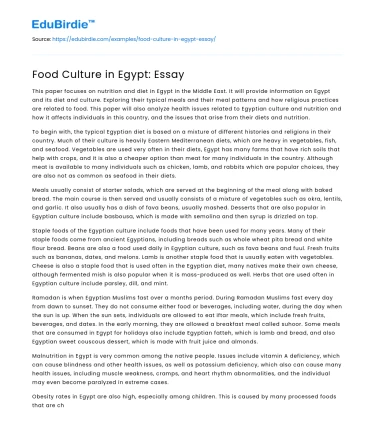This paper focuses on nutrition and diet in Egypt in the Middle East. It will provide information on Egypt and its diet and culture. Exploring their typical meals and their meal patterns and how religious practices are related to food. This paper will also analyze health issues related to Egyptian culture and nutrition and how it affects individuals in this country, and the issues that arise from their diets and nutrition.
To begin with, the typical Egyptian diet is based on a mixture of different histories and religions in their country. Much of their culture is heavily Eastern Mediterranean diets, which are heavy in vegetables, fish, and seafood. Vegetables are used very often in their diets, Egypt has many farms that have rich soils that help with crops, and it is also a cheaper option than meat for many individuals in the country. Although meat is available to many individuals such as chicken, lamb, and rabbits which are popular choices, they are also not as common as seafood in their diets.
Save your time!
We can take care of your essay
- Proper editing and formatting
- Free revision, title page, and bibliography
- Flexible prices and money-back guarantee
Meals usually consist of starter salads, which are served at the beginning of the meal along with baked bread. The main course is then served and usually consists of a mixture of vegetables such as okra, lentils, and garlic. It also usually has a dish of fava beans, usually mashed. Desserts that are also popular in Egyptian culture include basbousa, which is made with semolina and then syrup is drizzled on top.
Staple foods of the Egyptian culture include foods that have been used for many years. Many of their staple foods come from ancient Egyptians, including breads such as whole wheat pita bread and white flour bread. Beans are also a food used daily in Egyptian culture, such as fava beans and fuul. Fresh fruits such as bananas, dates, and melons. Lamb is another staple food that is usually eaten with vegetables. Cheese is also a staple food that is used often in the Egyptian diet, many natives make their own cheese, although fermented mish is also popular when it is mass-produced as well. Herbs that are used often in Egyptian culture include parsley, dill, and mint.
Ramadan is when Egyptian Muslims fast over a months period. During Ramadan Muslims fast every day from dawn to sunset. They do not consume either food or beverages, including water, during the day when the sun is up. When the sun sets, individuals are allowed to eat iftar meals, which include fresh fruits, beverages, and dates. In the early morning, they are allowed a breakfast meal called suhoor. Some meals that are consumed in Egypt for holidays also include Egyptian fatteh, which is lamb and bread, and also Egyptian sweet couscous dessert, which is made with fruit juice and almonds.
Malnutrition in Egypt is very common among the native people. Issues include vitamin A deficiency, which can cause blindness and other health issues, as well as potassium deficiency, which also can cause many health issues, including muscle weakness, cramps, and heart rhythm abnormalities, and the individual may even become paralyzed in extreme cases.
Obesity rates in Egypt are also high, especially among children. This is caused by many processed foods that are cheaper for the natives who are unable to afford healthier foods. The obesity rate among children 6-9 years old was 14.9% in Egypt. This can affect many children in Egypt due to health issues that arise with obesity. Adults also struggle with obesity in Egypt with 35% considered obese. Physical activity is an issue in Egyptian culture, where adults and children are not getting enough exercise. Many poor families turn to potato and rice dishes and do not count calories. Health-related issues that come from obesity include high blood pressure, cancer, diabetes, and breathing problems.
It was interesting to learn about the cultural differences and nutritional diets and practices that Egypt in the Middle East has. Religion and other factors show how different cultures can be, how diets and nutrition may be affected by those, and how different health issues arise with different cultures and their diets.






 Stuck on your essay?
Stuck on your essay?

